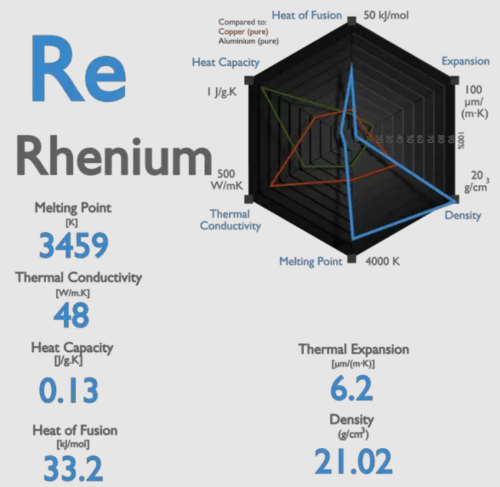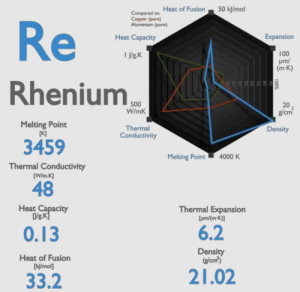Rhenium--the Metal with a Remarkably High Melting Point

Introduction
Rhenium may not be a household name, but in the world of science and industry, it stands out for its astonishingly high melting point of approximately 3,180 degrees Celsius. This often-overlooked metal plays a vital role in a wide range of applications. We’ll explore its ability to withstand extreme environments in this article.
What Is Rhenium?
Rhenium is a silvery-white, heavy transition metal with the chemical symbol Re and atomic number 75. It was discovered relatively recently in 1925 and was named after the river Rhine in Europe. This metal is one of the rarest elements in the Earth's crust, and it's often found associated with other rare metals like molybdenum.

Rhenium the Metal
Rhenium's Extraordinary Melting Point
Rhenium boasts an incredibly high melting point of approximately 3,180 degrees Celsius (5,756 degrees Fahrenheit). It has the third-highest melting point of any naturally occurring element, only surpassed by carbon and tungsten. Within the category of metallic materials, this silver-white metal has the second-highest melting point after tungsten. This exceptional property arises from the strong metallic bonds within its crystalline structure.
Related reading: Metal With High Melting Point | Top 10 Metals With High Melting Points
Applications of Rhenium's High Melting Point
Rhenium's exceptional high melting point has led to its use in a variety of demanding applications across several industries. Some notable applications of rhenium's high melting point include:
- Aerospace Industry: Rhenium is used in the aerospace industry for manufacturing components of jet engines and other high-temperature applications. Its ability to maintain its strength and integrity at extreme temperatures ensures the reliability of aircraft engines.
- Filament Materials: Rhenium and rhenium-tungsten alloys are employed in the production of filaments for mass spectrometers, X-ray machines, and other equipment. The high melting point is crucial in these applications where filaments are exposed to intense heat.
- Nuclear Applications: Rhenium is used as a target material for nuclear research and in high-temperature environments of nuclear reactors.
- Thermocouples: Rhenium wire is used in thermocouples for measuring high temperatures, particularly in scientific and industrial settings.
- Electrical Contacts: The high melting point and electrical conductivity of rhenium make it valuable for electrical contacts in spark plugs, vacuum tubes, and other high-temperature electrical applications.
- X-ray Tubes: Rhenium is used in X-ray tubes for its heat resistance and electrical conductivity, ensuring consistent performance in medical and industrial imaging.
- Catalysts: Rhenium catalysts are utilized in various chemical processes, such as the production of high-octane gasoline and the removal of harmful sulfur compounds from fuels.
Other Metals with High Melting Points
Several other metals and elements exhibit high melting points, although not as extreme as rhenium's. Here are a few notable examples:
- Tungsten (W): Tungsten has the highest melting point of any metal and is often used in high-temperature applications, such as in the aerospace industry, electrical contacts, and the production of light bulb filaments.
- Molybdenum (Mo): Molybdenum has a high melting point and is used in the aerospace industry, electrical contacts, and as an alloying element in steel to enhance its strength and corrosion resistance.
- Iridium (Ir): Iridium is known for its high melting point and is used in electrical contacts, spark plugs, and in the manufacture of high-temperature crucibles and electrical filaments.
- Niobium (Nb): Niobium has a high melting point and is used in the production of superalloys for jet engines, particle accelerators, and other high-temperature applications.
- Hafnium (Hf): Hafnium is employed in high-temperature ceramics, nuclear reactors, and the aerospace industry due to its excellent high-temperature properties.
- Platinum (Pt): Platinum has a relatively high melting point and is used in various high-temperature applications, including laboratory equipment, electrical contacts, and catalytic converters.
Conclusion
In a word, rhenium's incredibly high melting point is a defining feature, and it sets it apart from many other elements. This unique property, along with its excellent heat and electrical conductivity, makes rhenium a critical component in a wide range of applications. They include aerospace engineering, medical diagnostics, nuclear research, etc. Despite its rarity, the remarkable characteristics of rhenium ensure its enduring importance in various industries.
If you're eager to delve deeper into the world of rhenium and other refractory metals, we recommend a visit to Advanced Refractory Metals (ARM). ARM provides a wealth of information and resources to address your specific needs in the realm of refractory metals.
Reference:
[1] Rhenium – Melting Point – Boiling Point. Nuclear Power. https://www.nuclear-power.com/rhenium-melting-point-boiling-point/
{{item.content}}
LEVE A REPLY
{{item.children[0].content}}
{{item.content}}






